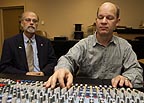December 16, 2005
Music school's recording studio nearly complete
CARBONDALE, Ill. -- The $11 million makeover of Altgeld Hall resulted in new interiors, utilities and a 20,000-square-foot addition. But the final piece of the renovation is taking shape in a small room deep inside the 109-year-old building housing the Southern Illinois University Carbondale School of Music.Brian C. Wagner, music instruction specialist, is hooking up the building's new professional-quality recording studio. The studio, some of which still sits in factory packaging, will provide students with the opportunity for increased hands-on experience in recording live music. In turn, it will strengthen SIUC's course offerings aimed at aspiring music business professionals.
The studio equipment is a balance of cutting-edge digital recording equipment and tried-and-true classic analog pieces. Wagner, a 25-year veteran of working with broadcast and recording equipment, said students will get a good balance of experience using the equipment.
"It's close to state-of-the-art. It's got some of the latest computer-driven equipment out there," Wagner said as he gave a tour of the unfinished space. "I tried to think down the road with the equipment. It's nice stuff. For students to get hands-on experience like this, that's rare."
Gone are the days of wide tape rolling through a reel-to-reel machine. In most cases, a computer will handle much of the front-end processing of incoming sound signals before turning it into digital information and storing it on a hard drive. Students will gain experience using well-established professional recording software to make their recordings, Wagner said.
Included in the $150,000 budget for studio equipment are several remote recording units and high-quality microphones. Wagner said engineers also will be able to record two events at two places at the same time, if necessary.
Once the studio is finished, technicians and students will be able to record performances in the orchestral and jazz band rehearsal rooms, which lie on either side of the recording studio separated by walls and large windows. Construction crews also took the opportunity presented by the building-wide makeover to run dozens of cables through the structure to nearby Shryock Auditorium, making it possible to record performances there using the top-notch equipment in the studio.
One of Wagner's main tasks at this point involves hooking those cables – and dozens of others – to the equipment. It's a time-consuming, technical undertaking that involves a great deal of planning followed by many tedious hours of building and then connecting patch cables.
Robert Weiss, director of the SIUC School of Music, said he hopes to have the studio functioning by the start of spring semester. Students could start using it as early as fall 2006.
"This facility will give students more hands-on opportunities to learn," Weiss said. "It's a very high-level recording facility."
The school offers two classes in recording technology in conjunction with the Department of Radio-Television, which also has a recording studio. The new studio likely will be used by students in the school's music business specialization, which prepares students for work in the music industry. Weiss said the existing and new studio will compliment one another.
Evaluating and funding new technology based on its ability to add value to the student learning experience is among the goals of Southern at 150: Building Excellence Through Commitment, the blueprint the University if following as it approaches its 150th anniversary in 2019.

